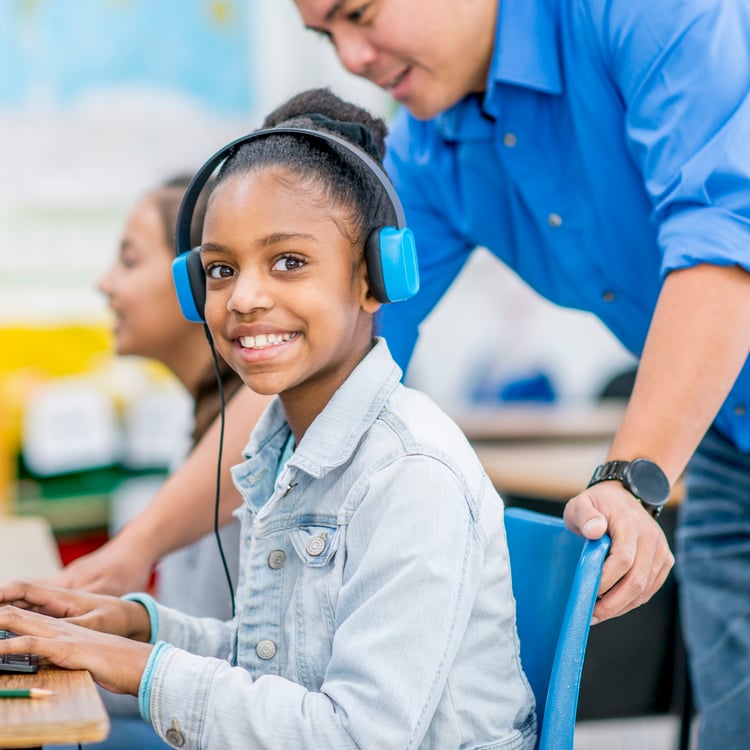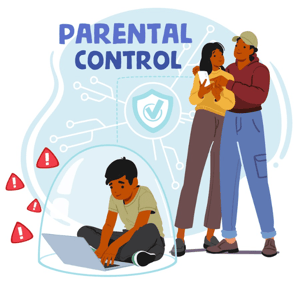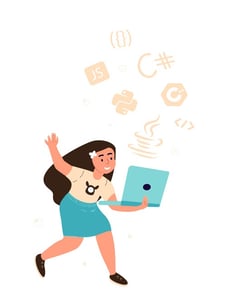Teaching coding for kids can be difficult—especially if you’re not too familiar with programming concepts yourself. Conventional, text-based coding can be pretty overwhelming, what with the seemingly nonsensical combinations of symbols, numbers, and characters.
Just looking at the wall of text is enough to make an adult feel out of their depth – never mind a child!
Nowadays, the benefits of learning coding have become too prevalent to be ignored. In response, the demand for kid-friendly coding platforms and coding lessons has risen. At least half a hundred companies have answered the call. There are now a few dozen coding websites for kids, and most (if not all) boast stellar reviews.
From free coding websites to paid coding websites for kids, the options are almost unlimited. If you or your child are interested in learning how to code, these 31 programs are your best bet.
Table of Contents
CodaKid

CodaKid is an online program focused solely on teaching coding for kids through game development and modding (creating game modifications) for Minecraft. Their aim is to make coding lessons more interesting – and more memorable – through direct interaction and practical, hands-on application.
Rather than the standard, generalized programming lessons (like writing “Hello World!” on a colored background), CodaKid students are instead given unusual and exciting projects to tackle i.e., forging their own Minecraft sword, creating a Rollercoaster Tycoon-type Roblox game, or designing their own unique Minecraft monster—and bringing it to life.
CodaKid encourages self-styled learning as you go. Every lesson focuses on creation through coding; whether it’s a simple Infinite Runner-style game or a fully interactive 3D platformer using Unreal Engine 4 (the same professional game engine used to make the best-selling game, Fortnite).
With dozens of specialized courses to choose from like Minecraft, Roblox, Game Programming, Scratch Coding, and more, there’s no shortage of new concepts to learn and fun assignments to tackle.
The platform is part web-based and part client-based. This means that some parts of the lesson content—particularly the tools, software, and projects—will be downloaded to your device. This gives your child full ownership and access to every coding project he or she completes, as well as the means to run it or edit it as they wish.
CodaKid lessons come in the form of professional video tutorials that kids can consume at their own pace. They’re also designed to make programming concepts appealing and easy to understand without sugar-coating them. In other words, CodaKid students aren’t given a watered-down or over-simplified version of coding. The lessons are incredibly effective – despite the complexities and technicalities of textual coding – thanks to the platform and context with which they’re introduced.
This excellent balance of real coding language presented using a fun and engaging platform minimizes the risk of frustration and maximizes knowledge retention. This, in turn, can make students feel like real programmers and software engineers.
For the more technology-inclined kids, this feeling can be incredibly satisfying.
CodaKid lessons also use professional programming tools to code with real programming languages, like Python and JavaScript. This makes CodaKid one of the best coding websites for kids interested in web, app, and game development.
Scratch
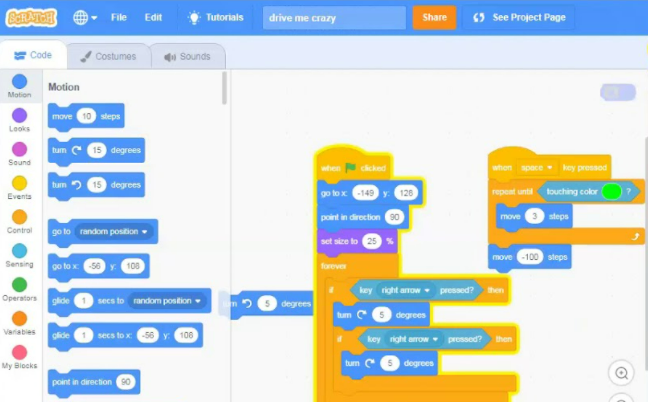
Scratch is a revolutionary, block-based visual programming language and platform designed primarily for kids—specifically, children aged 7 and up. Developed by MIT Media Lab, translated into 70+ languages, and 100% free, it’s by far one of the best free coding websites for kids out in the market right now.
The numbers speak for themselves: as of April 2020, Scratch has hosted more than 52 million projects shared by over 54 million users.
(Scratch or CodaKid? Check out our comparative CodaKid versus Scratch analysis here!)
As a block-based, drag-and-drop coding language, Scratch is one of the easiest ways to introduce kids to programming. Statistically, the visual nature of this coding language eliminates syntactical errors by letting users build executable scripts using graphical blocks rather than phrases, sentences, and symbols.
This is known as block coding, and it’s proven to be incredibly effective in teaching coding for kids. The risk of simple syntax errors (like forgetting a colon or mixing up a closed parenthesis with a closed bracket) getting in the way of learning coding fundamentals is greatly reduced. What’s more, bold lines, bright colors, and distinct shapes are far more appealing to children, thus encouraging them to keep exploring.
Scratch’s library of sprites, objects, backgrounds, music, and other programmable elements is incredibly extensive. So the chances of kids getting bored with the options are pretty low. But if kids do want to code their own character in Scratch, they can simply import their own vector-based graphics into their existing library to customize their game.
Users (also called “Scratchers”) can even create their own code blocks and add new logic to existing programs.
Scratch also encourages community creativity. Every time you save a project, you have the option to share it on Scratch’s community page (think IG’s explore page, but for coding). Other Scratchers can then view it and like it.
They may even draw inspiration from it and try to replicate it. This is easily done with the “See Inside” button. This option allows users to open the project’s editor to see the project’s scripts. This can help kids and aspiring coders understand how more complicated codes function. It can also give them something to aim for without starting completely from scratch.
Kids 4 Coding
This coding website for kids offers both Virtual and On-Campus learning programs covering computer science courses. Their week-long tech camps are geared towards teaching kids how to code games, apps, websites, and more. However, due to the current global pandemic, their in-person programs in all their Boston and Atlanta locations have been delayed ‘til summer 2022.
But until then, their Virtual Tech Camps for kids and teens are available all year-’round.
Now on its 8th year of operation (as of 2021), Kids 4 Coding continues to partner with established tech experts, educators, and entrepreneurs to develop a highly engaging curriculum—one that promises to “bridge the gap” between traditional academic learning and practical knowledge useful in our ever-evolving, tech-centered society.
The lessons, courses, and subject matter are constantly updated to accommodate new trends, new technologies, and new demands as they happen.
Currently, Coding 4 Kids offers more than a dozen virtual courses covering Scratch Programming (for kids aged 7 to 9), 3D Game Development, Minecraft, Python Programming (for kids aged 10 to 12), and JavaScript.
They also have more advanced courses, like mobile app development and Adobe Photoshop, for kids aged 11 to 16. They promise more effective group classes with a limited 5:1 student-teacher ratio for optimal focus and hands-on teaching.
Glitch
Glitch describes itself as (1) a simple tool for creating web apps, (2) a friendly, creative community, and (3) a different kind of coding program. And, to be fair, the concept is quite unique!
Glitch is a collaborative programming environment that allows developers to work together on code in real-time. Think of it as the Google Docs of coding apps: you have a code that multiple people can access, view, and edit live. Programmers can leave comments, make changes, and collaborate with the people they want to achieve optimal, industry-standard results.
While this platform is suitable for older kids, we feel it’s worth including it as one of the best coding websites for kids, as it can challenge interested children and push them to improve their coding skills. The collaborative aspect of the platform makes it possible for young programmers to receive support and guidance – whether from their teacher or their fellow coders – as they work on their code.
There’s also a community of experienced developers ready to answer any and all questions your kid may have about Glitch or programming in general.
Because there’s no need to worry about servers or setup, kids can literally just jump in on a project and start writing. As a bonus, there are also millions of fun, useful, community-created apps that your kid can only find and access via Glitch.
Khan Academy

Khan Academy is an online nonprofit organization whose mission is to provide “free, world-class education for anyone, anywhere.” It offers over 10,000 instructional videos, 3,000 unique articles, and more than 50,000 practice exercises that cover a wide range of topics. On top of their math, chemistry, physics, and biology courses, Khan Academy offers computer science and engineering courses, too.
As a personalized learning resource for all ages, they focus on skill mastery (rather than memorization) to help establish strong educational foundations.
Khan Academy students can study at their own pace by downloading videos and watching them on their own time. They also have the option to choose courses that suit their preferences and track their own progress using Khan Academy’s comprehensive Student Dashboard. They may start in-house discussions as well by leaving recommendations and ratings on videos, posting comments, and communicating with fellow Khan students taking the same course.
Khan Academy coding content is presented in an engaging and easygoing manner. Complex technical terms are kept to a minimum, and the teaching/testing language is completely conversational. As far as computer programming and coding for kids courses are concerned, Khan Academy promotes hands-on knowledge for JavaScript, HTML/CSS, and SQL.
When you join Khan Academy, you’re joining a global classroom. This no-cost, free-for-all platform is available in over 36 languages worldwide.
(Want to know more? Read our updated Khan Academy review!)
UCode: Programming Academy
If you prefer your child learns coding in a traditional online coding academy model – with class schedules and live teachers – UCode is a good choice. Nationally recognized since 2009, UCode is a virtual academy that offers live coding classes for students aged 7 to 18 at an affordable price.
UCode’s current curriculum consists of STEM-based programs (suitable for kids 7 to 8 years of age), Python coding lessons (for 8 to 10 years), Native Python classes (for 14 to 18), and foundational HTML/CSS courses (for ages 11 to 15).
Students can enroll in four (4) 60-minute Entry Level Classes/month or eight (8) 60-minute Entry Level Classes/month. They also limit classes to no more than 6 students per class (and per instructor) in order to maximize personal, hands-on teaching.
UCode’s mission is to equip kids with the skills they’ll need to navigate an ever-evolving society that is almost wholly dependent on technology. They believe that the jobs of the future will require skills that are “generally only available to the digital aristocracy,” and they aim to rectify this through affordable education for everyone.
CodeCombat
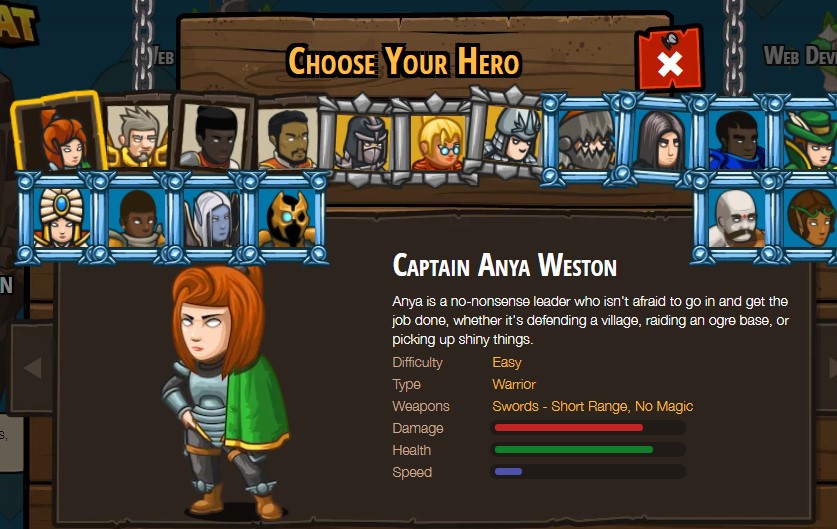
CodeCombat is different from other coding websites for kids in the sense that it is, entirely, an online game. To be more specific, it is designed as an adventure/dungeon-delver/RPG-style game that teaches coding basics through combat and exploration.
Players control their characters by writing out actual code using either JavaScript or Python. Hack-and-slash, turn-based combat scenes are expertly combined with logic puzzles and fantasy elements to create a fun, lighthearted challenge.
The game is free to play, but there is a paid version that unlocks Game Development, Web Development, and other more advanced Computer Science modules.
(What other fun stuff can CodeCombat offer your child? Check out our extensive CodeCombat review to learn more!)
A lot of kids enjoy stories about knights and dragons, heroes and dungeons. CodeCombat leverages this inclination for fantastical concepts to successfully introduce the fundamentals of programming in a way that is enjoyable and exciting (rather than mechanical and overwhelming).
Instead of viewing each coding concept as an academic lesson that must be learned, kids see the syntax and scripts as parameters that must be achieved to win.
CodeCombat uses bold, colorful graphics to appeal to younger audiences. The player characters (called heroes) all have distinct appearances, personalities, and backstories for further engagement. There are 17 of them in total; four of which are free, three of which are available with a subscription, and ten of which can be bought with a subscription and gems.
These characters, coupled with the RPG maps, art assets, and immersive sound effects, all come together to make this one of the best and most addictive coding games for kids. The CodeCombat world is fairly massive. There are 10 stages in total, all of which have a good dozen or so levels (the Backwoods Forest and Cloudrip Mountain have over a hundred, in fact) in them. It’s enough to keep a child occupied for a fairly lengthy amount of time.
With CodeComabt, kids need to keep coding if they want to keep playing.
Codecademy
Codecademy is another excellent platform for young, aspiring programmers to pick up the basics of coding. It’s an online academy (much like Khan Academy), so there is a set curriculum with units, lesson plans, and courses that students can choose to enroll in. There are also interactive quizzes, take-home projects, supplementary materials, and approved resources that students use to test their aptitude.
Like many paid coding websites, paying for a subscription unlocks a number of benefits and bonuses that aren’t available under the free or trial plan. Codecademy offers valuable text-based modules on web development and programming languages for both free and paid accounts, but paid accounts are given access to additional hands-on lessons.
(Is Codecademy the best choice for your child? Our Codecademy review can help shed a little more light on the answer.)
Codecademy believes in personalized, self-paced learning. Students can choose where they’d like to start and how they’d like to go about it. Kids could start smack dab in the middle—say, the basics of web development in HTML & CSS—and work their way backwards if they wanted to. Kids could also jump back and forth between JavaScript, Python, and SQL if they were so inclined.
With Codecademy, you’re free to do whatever works best for you.
Intermediate to experienced coders may find themselves growing bored with the limited learning material, but that’s simply because Codecademy’s curriculum isn’t designed for them. Codecademy chooses to focus on teaching and strengthening the basics of coding in order to give young programming enthusiasts a truly solid foundation. Their coding for kids courses is specifically designed to be fun, engaging, and easy for beginners—which is why their classes only go as advanced as Ruby, PHP, and AngularJS.
Codecademy also has an excellent forum community full of professionals, veterans, and fellow Codecademy students. It’s organized into four categories: Get Help, Community, Projects, FAQ. For a paid Codecademy account, students can even get live support.
MIT App Inventor
MIT App Inventor is a simple, kid-friendly, block-based computer programming platform from Google. It allows users to build their own Android Apps using a visual, drag-and-drop coding environment (like Scratch). The blocks in MIT App Inventor are called components, and they range from the simple button, image, and text elements to more elaborate options like animations or an “accelerometer sensor” (an MIT App Inventor component that works like a Wii controller).
Although not specifically targeted towards kids, the MIT App Inventor’s setup provides a low entry point that allows people of all ages and skill levels to create fully functional apps for smartphones and tablets. Like block-based programming, all the user needs to do is move the components they want onto the screen and connect them.
It may not be as blocky and brightly colored as, say, Scratch and Scratch Jr., but it’s still very visual. And we’d argue that the simplicity in the design allows for a pretty broad age range.
As a coding program, MIT App Inventor doesn’t just throw users straight into the deep end. There’s an extremely helpful Getting Started page that covers setup instructions, an editor overview, extensive beginner tutorials, and how to package and share apps.
The Tutorials page itself is quite hefty and has well over twenty or so tutorials that you can follow, step by step, to eventually master the App Inventor editor.
Your kid will definitely enjoy making Codi (the coding bee) buzz around or creating their own whack-a-mole app for some finger-mashing fun!
The Coding Space
The Coding Space is “an after-school and summer coding program” for kids that helps them develop critical thinking skills as they learn to code. Unlike other generalized online academies or virtual tutorials, The Coding Space emphasizes customized learning, self-paced study, and – most importantly – individualized attention. Both their in-person and live online coding classes stay at a strict 4:1 student-to-teacher ratio to guarantees hands-on teaching and personalized guidance.
The Coding Space has currently taught more than 2,500 students how to code using Scratch, WoofJS, JavaScript, HTML, and CSS. Their current program lineup includes their Fall Coding Program, Summer Coding Program, Private Classes, and GirlCode—a one-of-a-kind program with all-girl classes specifically designed to teach girls how to code.
Staying in male-dominated classes may be intimidating for young girls, and may – therefore – detract from their learning experience. By providing a safe, inclusive environment for girls, The Coding Space hopes to change the gender gap in tech.
Overall, The Coding Space aims to help kids foster intellectual confidence, growth mindset, and computational thinking skills through coding.
mBlock
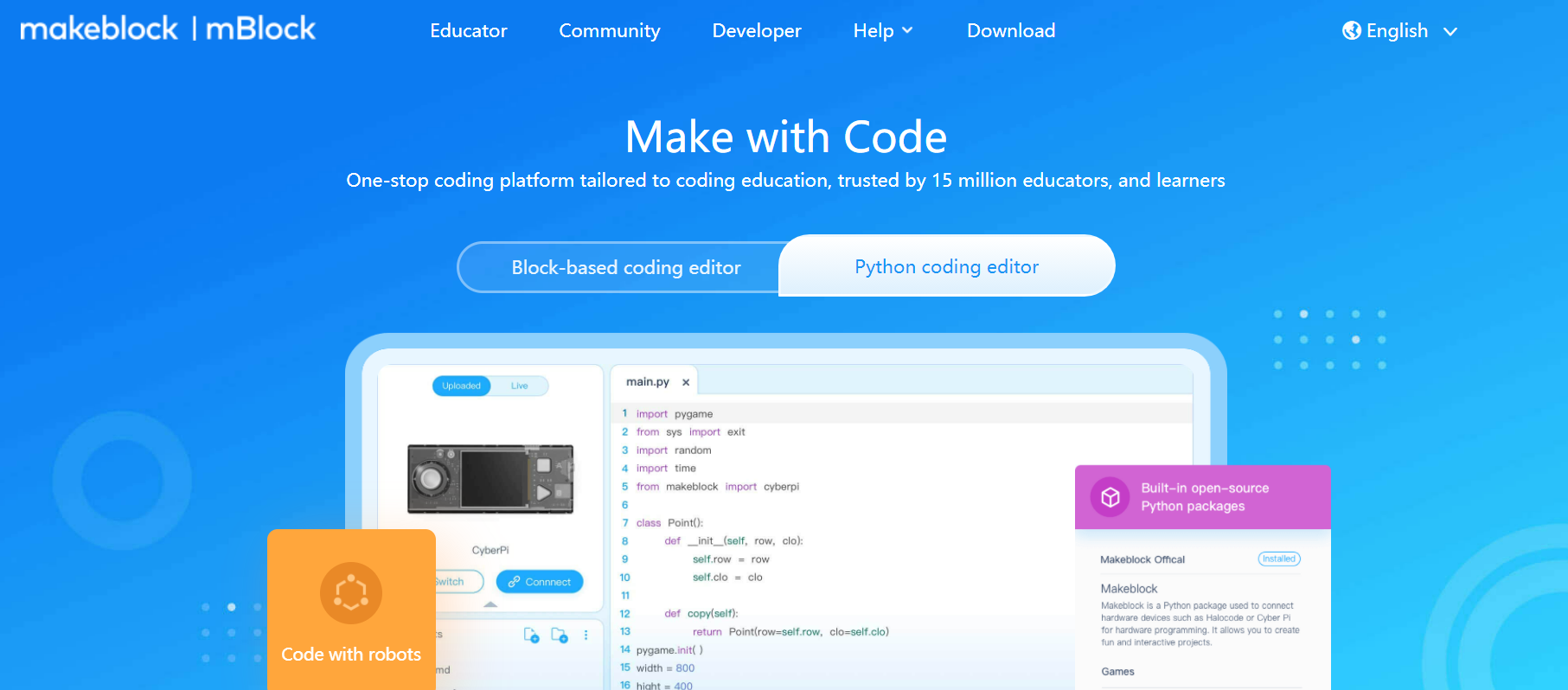
mBlock – or makeblock – is a STEAM programming software tool marketed as a “one-stop coding platform” created for education. It uses Scratch 3.0 and Arduino code to support both block-based and text-based programming languages. This simply means that your child can choose to learn via a visual drag-and-drop system using blocks (think Scratch or MIT App Inventor), or they can challenge themselves with some traditional text-based programming.
Whichever they choose, mBlock has the resources and professional capacity to fully support them throughout their education. Your kid can create fun games, animations, and interactive projects that they can later share with the mBlock community. They can also program robots and learn the fundamentals of AI systems.
mBlock is widely accessible and can be used across different devices. It supports Windows, Mac, Linux, Chromebook, iOS, and Android. There is no specified age range, but we recommend starting younger children out (aged 5 to 9) with the block-based coding editor.
Code Monster

If you’re simply looking for a quick, free, and child-friendly addition to your kids’ coding experience, Code Monster is a fun, excellent option. As the name suggests, this website teaches coding for kids using a friendly blue monster character.
The Code Monster guides kids through each interactive lesson. It asks assessment questions and provides helpful hints when necessary. It also introduces the basics of programming through carefully worded explanations and instructions.
Your kid can only move on to the next lesson, test, or project once they fulfill the monster’s parameters and/or successfully reach the goal.
As cute as this coding program can be, it’s really more of a supplementary platform than a standalone coding resource. The setup only allows for linear progression with little to no variation on the lesson plan.
On the one hand, this eliminates the risk of confusion or accidental advancement to more complicated modules without fundamental knowledge. On the other, this also means that there isn’t an opportunity to get creative with coding or to explore programming concepts further.
(Curious to see this little monster in action? Check out our detailed 2020 Code Monster review!)
Kidlo Coding
Kidlo Coding is a coding game for kids that teaches the very basics of programming: functions, sequences, debugging, loops, arrays, and etc. With more than 50 fun games crammed into one intuitive, well-designed program, children can learn how to build executable scripts using actual coding concepts and commands.
They will also learn how to run, clean up, and debug existing scripts using similar games in the same program.
One subscription is enough to unlock all the great games on this coding website for kids: Alien Escape, Dress-Up, Connect the Dots, Pop the Balloon, and more. The diverse nature of the games – and the sheer number of options available – can also help kids work on skills related to coding: problem-solving, logical thinking, sequential thinking, and memory.
Blockly
Marketed as “games for tomorrow’s developers,” Blockly is an online platform that teaches coding for kids using visual, block-based programming (like Scratch and mBlock) and fun, educational interactive games. Each game introduces a different coding concept and can be played using drag-and-drop block coding.
(Psst! Here’s why coding games are the best way to teach kids computer programming!)
The whole platform is designed with beginner coders and very young children in mind. Ergo, the entry point is quite low. Their goal is to give Blockly users the fundamentals they need before they move on (ideally) to conventional text-based programming languages.
The games on this website are made using the programming language with the same name; Blockly—a JavaScript library for building visual programming editors. This is (1) a clever way to market the capabilities of this block-based programming language, and (2) a visually enticing approach that could potentially encourage children to make their own simple games using Blockly.
As with some other free and paid coding websites on this list, Blockly is a purely web-based program. All you need is a device to access the internet and a stable connection. The Blockly editor represents coding concepts as interlocking blocks, and it can be downloaded to your device.
All eight Blockly games are available for free, and they range from puzzle games to logic games to sequential challenges. They’re quite simple and only allow for linear progression, but there’s no denying that they introduce and implement coding concepts quite well. The different rules and genres should be enough to encourage children to keep playing until they’ve tried all eight games.
CodeWizardsHQ
CodeWizardsHQ is a coding for kids website that’s been offering virtual programming courses for kids aged 8 to 18, and it’s been around for more than 10 years. Their curriculum covers popular coding languages like Scratch, Python, and JavaScript. Practical skills include web and app development, programming user interfaces, VR game creation, and more.
There are roughly seven (7) programs categorized by age group and skill level, and each program has at least one Wizard Level.
Wizard Levels are basically made up of three (3) core courses, and each course has 12 lessons in it. So it’s fair to say that, in terms of available content, CodeWizardsHQ’s curriculum is quite meaty. Classes run for an hour every week, and they’re led by a live instructor to help guide students and keep them focused. They only allow a maximum of 7 students per class, so kids won’t have to fight for attention during the session.
The classes mostly consist of hands-on activities and projects, and they’re all held in CodeWizardsHQ’s “Headquarters”—their customized online classroom exclusively built for CodeWizardsHQ students.
If your child misses a class, don’t worry; CodeWizardsHQ has a few policies that make it easy to catch up. First of all, all class sessions are recorded. These recordings are then given to the students – along with teaching slides – shortly after class has ended.
Second, CodeWizardsHQ offers a full suite of beyond-the-classroom benefits (including supplementary resources) that your child can use to help them understand any missed lessons.
When all else fails, students also have the option to send their teacher a direct message via the student platform. CodeWizardsHQ has a private, monitored chat feature that kids can use to ask their instructors questions outside of class hours.
All in all, CodeWizardsHQ quality speaks for itself. Do be aware that of the top coding websites for kids, it’s also one of the more expensive options. Many do feel that, given the benefits packaged in with the lessons and the top-tier instruction, the price is justified. But if you aren’t a hundred percent sold on their curriculum, they do have a comprehensive 30-Day Money-Back guarantee.
freeCodeCamp.org
Featured in reputable news outlets such as The New York Times, Time, Quartz, USA Today, and BBC, freeCodeCamp is a donor-supported nonprofit organization whose mission is to help people learn to code for free. Since 2014, more than 40,000 freeCodeCamp alumni have secured software engineering jobs (and similar positions) at big tech companies like Spotify, Amazon, and Microsoft.
Covering a wide range of computer science lessons like HTML5, Responsive Design, JQuery, Back-End Development, Automated Testing, Python, and Kanba, freeCodeCamp is an incredibly extensive coding resource center. Their teaching style focuses on hands-on learning and practical application. Students may be required to complete actual coding projects that carry weight in the real world, like building a website for an NGO.
FreeCodeCamp students can even earn verified certifications for Responsive Web Design, Front End Libraries, Scientific Computing with Python, Data Analysis with Python, and other similar courses.
Although this program isn’t specifically targeted towards kids, freeCodeCamp can still be considered a viable coding for kids website due to its extensive beginners’ modules. If not kids, then teenagers. Either way, it’s an excellent, award-winning platform that is 100% free to use.
Stencyl
Stencyl is a “powerful game creation toolset” that utilizes the drag-and-drop, snapping blocks system. Just like Scratch, Blockly, and mBlock, the use of visual graphics makes it a great programming platform for new coders and young programmers.
Centered on game development for kids, Stencyl is an intuitive and interactive platform that allows students to create, develop, test, and – ultimately – distribute their own games on the iOS App Store and Google Play. So if your child loves the thought of designing and developing games, this could be the program that jumpstarts their promising career at a very young age.
Rather than introduce programming concepts by playing games, Stencyl encourages users to learn said concepts in order to make games.
Stencyl works closely with schools to provide meatier content for their computer science curriculum. Teachers and school administrators can use Stencyl’s free Educator’s Kit to design lesson plans or create supplementary take-home courses. Younger children – aged 6 to 12 – may find it easier to learn basic coding concepts and related skills with Stencyl’s block-based programming system.
For experienced coders and older children looking for a challenge, Stencyl also offers lessons that encourage additional practice using text-based coding. If kids want to try their hand using conventional textural programming languages like Java or Python, Stencyl has plenty of resources and materials for them to learn from.
Regarding price, Stencyle offers free options for students on a budget. But if you’re fine with investing in it, their pro paid plans are perfect for knowledgeable programmers looking to improve their skills.
Code HS
Described as an “interactive online learning platform,” Code HS is a resource center wholly dedicated to spreading extensive knowledge of computer science and encouraging skill-building in the same area. It offers online, self-paced classes and teaching materials in the form of video lessons, exercises, and quizzes.
There are also live, remote tutors available for paid users.
Code HS teaching materials are great for independent students looking to develop their coding skills and institutions looking for computer science content. They’re based on Code HS’s professionally designed curriculum meant for students of all ages and all skill levels. It starts with a cursory introduction to basic computer science and then moves on to cover more advanced lessons: AP Computer Science Principles, AP Computer Science in Java, programming with JavaScript, and more.
Beginner-level programmers can learn and apply the foundations of CS through practical projects before moving on to the advanced modules.
Box Island
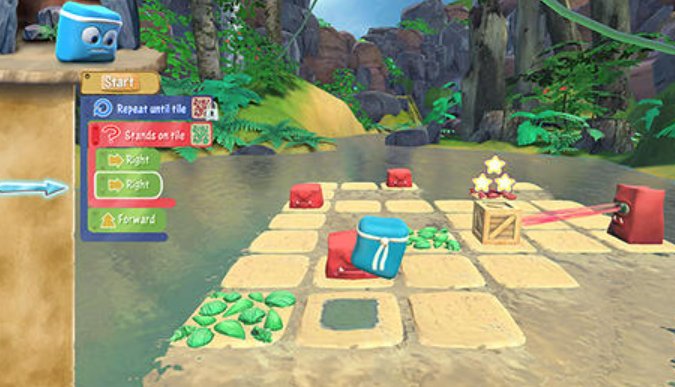
This fun, award-winning coding adventure for kids was initially an iOS exclusive. Thankfully, it’s now available on the Google Play Store for Android users.
Featured in Adweek, Mashable, TechCrunch, and The Guardian, Box Island is a brilliantly designed app for kids. It’s a fun, colorful, survival-style mobile game featuring friendly characters, detailed locations, and an interesting storyline that kids are sure to love!
Players get to explore over 100 beautifully designed levels along with the hero character (a bubbly, bright-blue box). Along the way, they’re taught coding basics like sequences, loops, and conditionals. As they complete each level, they further both the main story and their programming knowledge.
Box Island stands out from another coding for kids apps thanks to its cute storyline, quirky characters, high-quality graphics, and incredibly immersive world.
Swift Playgrounds
Available only for iPad users, Swift Playgrounds is a free app that teaches coding for kids using engaging, interactive puzzles, and stunning graphics. Much like CodeCombat, the app uses fantasy elements, original characters, and plenty of story-based levels to unlock and explore. Highly educational and visually appealing, we strongly recommend this app for young children starting out their coding journey.
Cargo-Bot
Cargo-Bot has the distinct honor of being the first game programmed entirely on an iPad using Codea—an iOS Lua code editor.
A cute and colorful puzzle game with 30 levels of fun graphics and fairly challenging objectives, this app covers basic programming concepts using a drag-and-drop block coding system—in the form of a handy toolbox. Players can drag different blocks (like direction blocks or prog blocks) from the toolbox to the editor to fulfill the intended outcome.
Like Box Island, you’re introduced to new coding basics as you progress in-game. There isn’t really an overarching storyline to the app, but the puzzles do get significantly harder as you advance. For kids who love a challenge, this should be plenty motivating!
Kodable
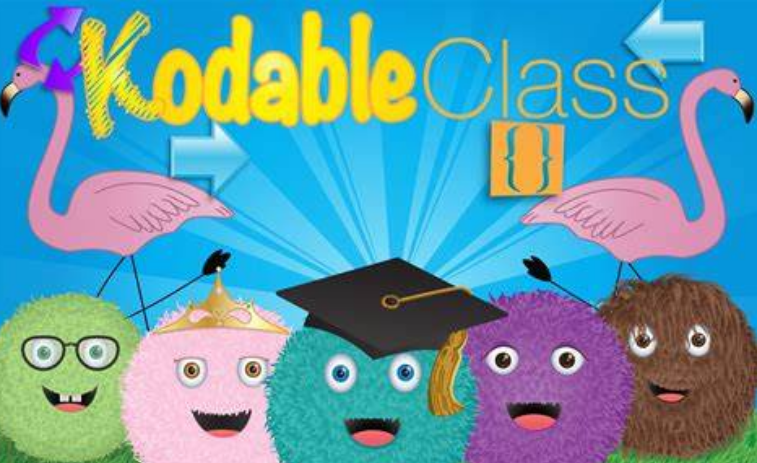
Edutopia describes Kodable as a “great way to introduce the concepts of programming,” while The New York Times lists it as one of the “best toys that teach kids how to code.” A fun, award-winning app that uses a complete K-5 curriculum (best for kids aged 4 to 19), Kodable’s reputation is practically unparalleled. Over 50% of U.S. Elementary Schools trust its content and its ability to teach kids coding.
Through Kodable’s interactive games with engaging storylines, kids can explore executable scripts, create personalized characters, and build their own levels. They’ll also get a chance to flex their critical thinking skills as they take on the many different challenges in this app.
Players start out using a drag-and-drop block coding system and eventually move on to conventional, text-based coding using programming languages like JavaScript. As they advance even further, they can even learn object-oriented programming.
Plus, teachers can use Kodable, too! If you are a teacher/educator, you have access to a whole host of Kodable-exclusive tools and systems via the app. These are incredibly helpful for creating courses, managing classroom accounts, and share programming projects with registered students.
Hopscotch
Bite-sized coding on your iOS device. That’s Hopscotch’s unique – and certainly attention-grabbing – subheading, and it certainly seems in line with their quick, quirky, and casual narrative.
One of the more colorful apps (and websites) we’ve had the pleasure of reviewing for this list, Hopscotch encourages users to “expand the canvas” of their imagination through their kids’ programming app. Designed specifically for ages 10 to 16, the Hopscotch Canvas (which is basically the app’s code editor) encourages users to express their personality, experiment to learn, and ultimately experience how software is made in a highly intuitive environment.
It utilizes visual, block-based programming coupled with fun, colorfully designed characters for a truly appealing programming experience. Kids can use the Hopscotch Canvas to make games, animations, mini websites, and interactive art projects.
Hopscotch’s paid option gives kids more advanced tools that unlock more potential projects, like creating AR (augmented reality) games (think Pokemon Go!).
LightBot
Available for both Apple and Android devices, LightBot is a fantastic platform that encourages on-the-go learning. This low-cost coding app seamlessly blends unique gameplay with bright, kid-friendly visuals to teach actual coding concepts. Sequencing, overloading, recursive loops, conditionals … your child won’t even realize that they’re learning technical jargon and syntactic, text-based programming. LightBot is just that fun!
If your kid loves solving problems and puzzles, they’re going to love this app.
SoloLearn: Learn to Code
An app that’s definitely targeted towards an older audience (we’d say maybe 10 and up), SoloLearn features the world’s largest collection of free programming courses for beginners to knowledgeable coders.
Through the app’s coding programs, users can choose to learn Python, C++, Java, JavaScript, jQuery, or all five programming languages if they so desire. They can opt to learn new concepts, brush up on existing knowledge, or stay informed about the latest coding trends.
Users can personalize their learning experience by picking and receiving content based on their preferences, progress, and areas of interest. They can also interact with SoloLearn’s huge community of coders; fellow programmers who are happy to provide peer support, evaluation, and remote assistance.
With over 15,000 questions and 2,000 different quizzes, there’s no better app for self-paced supplementary learning than SoloLearn.
codeSpark Academy
This award-winning app is lauded as the most-used home coding program for kids aged 5 to 9.
Based on curricula from MIT and Princeton, this bubbly, blocky, and brightly designed app teaches kids the “ABCs of computer programming.” As with most coding apps for kids, it does this through a variety of fun and interactive games. Kids can learn topics like Sequencing, Loops, Events, and Conditional Statements by playing specific games featuring the codeSpark Academy characters.
Each game has its own story, setting, and unique objectives. The characters are often recurring—specifically Woz and The Glitch. Woz acts as the user’s avatar, executing the instructions given by the user via the coding tray. Kids can fill the coding tray using the commands provided below it.
The Glitch, on the other hand, causes trouble for Woz. It’s the antagonist, so to speak, and is there to present viable challenges for the coder.
On top of the kid-friendly environment and generally vibrant appeal, codeSpark Academy has no in-app purchases or micro-transactions that your child could accidentally click on. Once you pay for the monthly subscription, there are no hidden paywalls. This means your kid can fully enjoy codeSpark Academy without needing constant supervision.
Hopster Coding Safari for Kids

Hopster Coding Safari for Kids is probably the only app on this list that’s catered for very, very young children; as young as 2 years of age, in fact!
Marketed as a pre-coding logic game, Coding Safari is an animal-themed, multi-puzzle game that recognizes and thoroughly supports the importance of coding for kids. The games here are designed to give children a head start on their coding journey.
Their goals are, in fact, twofold: (1) introduce children to computational thinking, and (2) deliver key computer science standards for UK and U.S. Curriculum.
Kids will have so much fun as they help Tiger get back to her den, Penguin returns to its Antarctic Ice Hole, and Monkey reach that ever-so-coveted banana tree. There are plenty of cute characters and engaging puzzles to keep kids entertained as they consequently pick up the fundamentals of coding, critical thinking, planning, and problem-solving.
CodeKarts
Suitable for children as young as four years of age, CodeKarts is marketed as a “pre-coding” game (like Hopster Coding Safari) that’s perfect for giving preschoolers a jumpstart in coding. Designed and presented as a racing game, kids learn the basics of coding as they navigate their way through different racetracks, facing obstacles and challenges along the way.
Aside from fundamental programming concepts, this app also encourages the development of observational skills, critical thinking, and logical reasoning.
GoldieBlox: Adventures in Coding
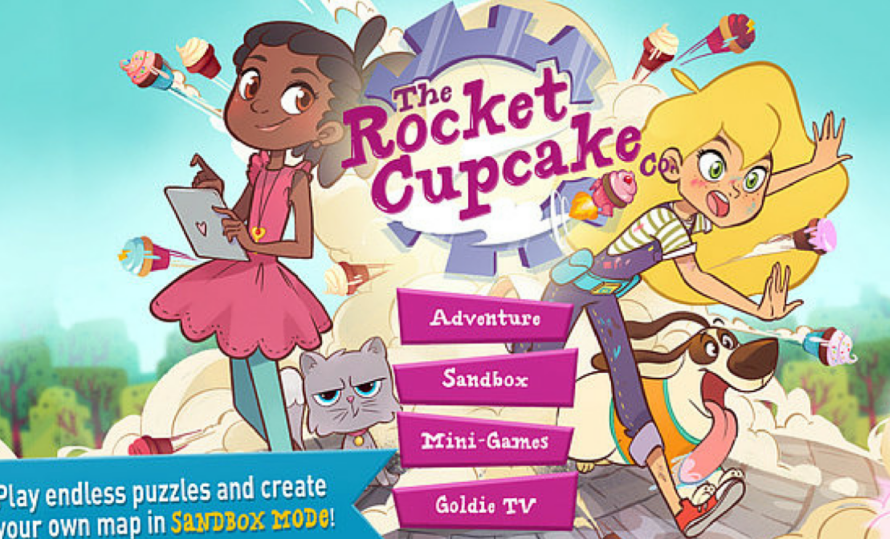
This story-based adventure app is a product line under the GoldieBlox brand—an American toy company that designs, manufactures, and markets toys and games specifically for girls. Their products are all crafted to encourage an early interest in engineering and unshakeable confidence in problem-solving.
The apps under the GoldieBlox: Adventures in Coding line are no different. They are all diverse, female-empowered, STEM-focused adventure games that teach coding concepts and fundamentals by way of puzzles and challenges pertinent to the story.
For instance, their The Rocket Cupcake Co. story requires players to travel throughout the town to deliver cupcakes. Players must program their routes using visual code blocks. Recommended for ages 7 and up, this app offers over 20 challenging Adventure Mode levels and an endless Sandbox Mode—a definite plus for replay value!
Scratch Jr.
Specifically designed for kids aged 5 to 7, ScratchJr. is a visual programming editor that allows kids to create their own interactive stories, games, and animations using the block-based language, Scratch.
Unlike most of the apps on this list, ScratchJr. doesn’t use games or puzzles to teach coding for kids. It instead provides tools and a canvas that kids can use to fully experiment and explore the capabilities of coding. Creativity and personality are highly encouraged as kids use ScratchJr. to build, define, and design their own projects.
(Read our in-depth review of ScratchJr. here!)
SpriteBox Coding
And last, but certainly not the least, is SpriteBox Coding. Another fun adventure game designed with first-time coders in mind, SpriteBox Coding features beautiful graphics and decently challenging puzzles that promise hours of entertainment. This app actually aims to change the way kids code as they progress through the game.
Users start out with coding blocks (called icons) to solve different coding puzzles. Over time, the icons are replaced with actual textual commands. This allows players to experience both visual and text-based programming. Kids will be introduced to sequencing, parameters, loops, nested loops, procedures, and other similar coding concepts as they collect stars and navigate a two-dimensional world.
SpriteBox Coding is available on both iOS and Android devices. However, there’s a slight difference between versions. iOS users will learn Swift coding syntax. For the Android app, users learn Java.
CONCLUSION
The tricky thing with teaching kids, in general, is that you need to grab and secure their interest. Once they no longer deem something worthy of their time and attention, the lesson is lost. And it can be very, very difficult to re-establish that desire to learn. Teaching coding for kids is no different.
Here’s a recap of our top coding websites for kids:
Table of Contents
- CodaKid
- Scratch
- Kids 4 Coding
- Glitch
- Khan Academy
- UCode: Programming Academy
- Code Combat
- Codecademy
- MIT App Inventor
- The Coding Space
- mBlock
- Code Monster
- Kidlo Coding
- Blockly
- CodeWizardsHQ
- freeCodeCamp.org
- Stencyl
- Code HS
- Box Island
- Swift Playgrounds
- Cargo-Bot
- Kodable
- Hopscotch
- LightBot
- SoloLearn: Learn to Code
- CodeSpark Academy
- Hopster Coding Safari for Kids
- CodeKarts
- GoldieBlox
- Scratch Jr.
- SpriteBox Coding
Thankfully, all the coding websites for kids and apps we listed here understand that. They’ve managed to leverage a myriad of different elements – like block-based programming, commanding visuals, and cute graphics – to make coding for kids fun and enjoyable. The fact that most of them are totally free and/or affordable doesn’t hurt, either.
